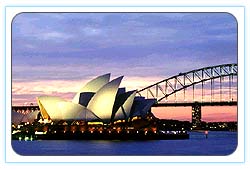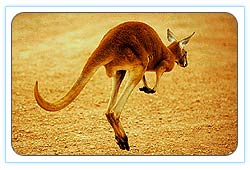|
|
|
|
|
|
|
Home »
Outbound Tours » Australia
|
|
|
|
Australia
|
|
|
 This country contains world-class cities, snowfields, deserts, rainforests and golden beaches. This alluring country captivates worldwide tourists due to its treasure of natural beauty, diverse landscape, distinct lifestyle and the warm culture. This country contains world-class cities, snowfields, deserts, rainforests and golden beaches. This alluring country captivates worldwide tourists due to its treasure of natural beauty, diverse landscape, distinct lifestyle and the warm culture.
Australians believe in enjoying their lives to the fullest; they relish their exquisite food and sports are the common pastimes for many Aussies.
Australia offers a wealth of travel experiences, from the drama of the outback and the spectacle of the Great Barrier Reef to the cosmopolitanism of Sydney and arguably the best beaches in the world. Australia is an enormous country, and visitors expecting to see an opera in Sydney one night and meet Crocodile Dundee the next will have to re-think their grasp of geography. It is this sheer vastness, and the friction between the ancient land steeped in Aboriginal lore and the New World culture being heaped upon it, which gives Australia much of its character.
Culture
Much of Australia's culture is derived from European and more recently American roots, but distinctive Australian features have evolved from the environment, aboriginal culture, and the influence of Australia's neighbors. The vigor and originality of the arts in Australiafilms, opera, music, painting, theater, dance, and craftsare achieving international recognition.
Although the effect of the arrival of Europeans on Aboriginal culture was profound and catastrophic, the reverse is not the case: broadly speaking, mainstream Australian culture has been imported from Europe, the United Kingdom in particular, and continuously developing since that time.
When to Go
Any time is a good time to be in Australia. Summer (December to February) can get uncomfortably hot but it's great beach weather. Up north, the summer wet season is very, very humid and the sea is swarming with box jellyfish. Winter (June to August) offers skiing in NSW and Victoria. In spring and autumn the weather is mild.
Climate
The northern Australia enjoys a tropical climate, and southern Australia a temperate one. The tropical states Queensland and the Northern Territory have highly predictable weather. In ``winter'', typical daily maximums are between 20 to 24 degrees Celsius and rain is rare. The beaches and tropical islands of Queensland and the Great Barrier Reef are perhaps at their most pleasant during this time of year. Further south, the weather is less dependable; in Melbourne in August maximums as low as 13 degrees celcius are possible, but can reach as high as 23 degrees.
In summer, the northern states are hotter and wetter, while the southern states are simply hotter, with temperatures up to 41 degrees in Sydney, Adelaide, and Melbourne but generally between 25 & 33 - very pleasant indeed.
 Major attractions Major attractions
Canberra : Canberra, the capital city of Australia, is a city comprising of politicians, bureaucrats - picturesque place with beautiful galleries and museums, as well as excellent restaurants, bars and cafes.
Canberra is Australia's federal capital. Established as part of Australia's federation in 1901, Canberra contains the national parliament, federal government departments, the High Court of Australia, the Australian War Memorial, and several other important institutions.
Canberra is comprised of five large "town centres" that lie in the valleys of the Canberra region. These are Central Canberra, Belconnen, Woden, Tuggeranong and Queanbeyan (actually in New South Wales) where Central Canberra is the only major area of tourist interest.
Great Barrier Reef : One of Australia's greatest assets is the magnificent reef that runs along almost the entire coast of Queensland. It is considered as one of the world's natural wonders and is the most extensive reef system and the biggest structure made by living organisms on earth.
Uluru : Uluru is the most famous icon of the Australian outback and a site of deep cultural significance to the Anangu Aboriginals. The 3.6km (2.2mi)-long rock rises a towering 348m (1141ft) from the pancake-flat surrounding scrub. It is especially impressive at dawn and sunset when the red rock spectacularly changes hue.
|
| |
|
|
|
|


